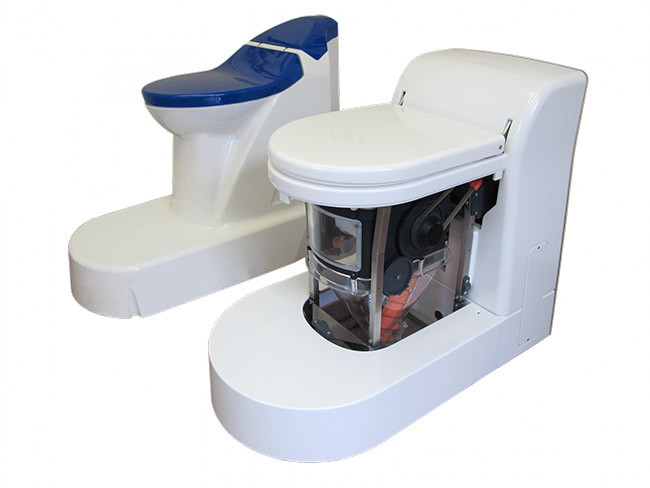How does Bill Gates' non-watering toilet work?
Four years after receiving a grant of US $ 710,000 from the Bill and Melinda Gates Foundation, the waterless toilet continued to receive a larger grant. Scientists are gradually improving this toilet model to soon apply in life.
According to Business Insider, the toilet is said to be named Nano Membrane by Cranfield University scientists. It is still under development research in the laboratory. But this is a very useful study because today more than 2.4 billion people worldwide are living in unsanitary conditions, lack of water. They do not have access to clean water, the risk of disease transmission in the community is very high. Nano Membrane is easy to use, no need to use water is a very good solution to prevent disease.

Alison Parker, a research team representative, said the Nano Membrane was designed to be deployed in rural areas with poor living conditions. However, due to the maintenance of this toilet model for 6 months, the group will test in some cities. Only when it improves and proves its useful technology, does the group deploy in remote areas, especially in Africa.
How the Nano Membrane works
After the user completes " work " and closes the toilet lid, the lid will push a bowl-like part inside the tub. The bowl will rotate 270 degrees to decompose the waste deposited into the lower compartment. A brush-like device will clean up the remaining waste in the bowl. The solid waste will stay on the bottom while the liquid waste will be pushed upward.
Very thin fibers, also called nanofibers, are arranged into strands of fiber inside the toilet. The bundle of fibers helps move the steam generated from liquid waste into a vertical pipe located behind the toilet compartment. Next, water passes through specially designed bundles of fibers to help the water vapor condense into the water. Water flows through the tubes and settles in the front compartment of the toilet compartment.
For solid waste, a battery-powered component pushes them out of the toilet and into a separate compartment. Solid waste is covered by aromatic wax and dried gradually.
Every week, the technician will go to the toilet location to remove water and solid waste from the outside, as well as replace the battery if the battery runs out. Rural people can use purified water from the toilet to water plants, clean the house, even cook and bathe! Solid waste can be put into factories for heat treatment to create an energy source for the community.
According to Alison, each toilet can serve 10 people at a very cheap cost of US $ 0.05 / day (equivalent to VND100). However, the deployment in large numbers will in fact encounter some obstacles. First, in areas where the Nano Membrane is deployed, it must be trained who can maintain this device. It will take no time to train. Secondly, Alison's group has not dealt with the issue of toilet paper either. Perhaps the user has no choice but to throw the paper in a container on the side.
You should read it
- Why are there two flush buttons on the toilet? Use the discharge button is correct
- Discover the history and exciting production process of toilet paper
- Incidentally: Used toilet paper can be recycled into electricity
- Should you throw toilet paper into the toilet or trash?
- [General] 10+ How to make toilets and bathrooms out of bad smell effectively, easy to implement
- Very fast and simple toilet seat switch with adhesive tape
- In your opinion, should you clean or wash after going to the toilet? The answer will startle you
- 6 reasons to use smart sanitary equipment
- Why does modern Japan still use squat toilets?
- Latest Skibid Toilet Attack Code
- Round eyes with 10+ most hegemonic toilet icons on the planet
- Is white or yellow toilet paper better?
May be interested

The first solar street in the world went into operation in Normandy, France

China claims to be the first country to bring the probe to the Moon's shadow in 2018

Finding a network of 320 genes causes epilepsy

Finding compounds can kill 25% of all cancers in the test environment

The blood pressure of women before conception can determine the sex of the fetus

Eating red peppers reduced by 13% the risk of death by stroke, cardiovascular






![Photo of [Infographic] Bill Gates started hacking and founding Microsoft, how did he become the richest person in the world?](https://tipsmake.com/data/thumbs_80x80/[infographic]-bill-gates-started-hacking-and-founding-microsoft-how-did-he-become-the-richest-person-in-the-world_thumbs_80x80_q3n7LZFQ3.jpg) [Infographic] Bill Gates started hacking and founding Microsoft, how did he become the richest person in the world?
[Infographic] Bill Gates started hacking and founding Microsoft, how did he become the richest person in the world? 5 Gates 'Must Read' books in 2014
5 Gates 'Must Read' books in 2014 How did Bill Gates start up?
How did Bill Gates start up? 17 interesting facts that few people know about billionaire Bill Gates
17 interesting facts that few people know about billionaire Bill Gates Bill Gates' successes and 'failures'
Bill Gates' successes and 'failures' Bill Gates announced four charts to prove the world is getting better
Bill Gates announced four charts to prove the world is getting better